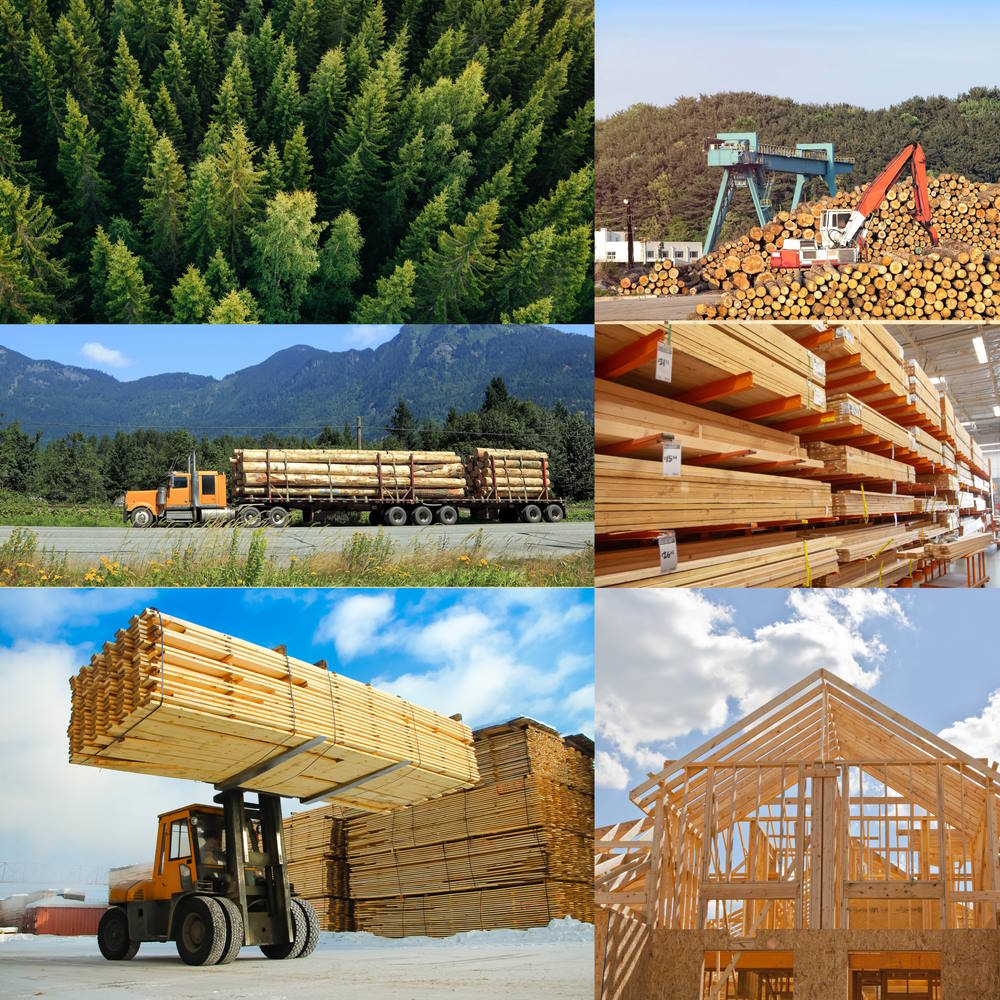Lumber Market Suffers from Home Buying Fatigue
Share This Story, Choose Your Platform!
Lumber prices have dropped 80% since soaring to all-time highs in May 2021. After a post-pandemic boom, a more subdued outlook took hold for home building, remodeling, and the United States economy. Home building and remodeling account for two thirds of U.S. consumption of lumber. This means lumber prices have a strong correlation with the U.S. home building market.
Fannie Mae’s most recent housing forecast is an improvement from the January forecast, but with total home sales projected at 4.67 million units, it would still be the slowest annual pace of home sales since 2011.
The most critical statistic for lumber futures is housing starts. U.S. housing starts are forecast to slow 24% in 2023 vs. 2022. With an elevated level of housing inventory, home builders are now expected to pull back on the pace of new permits. Thus, builders will likely focus on in-process and completed inventories in 2023.
Interest Rates Also Impact Housing, Lumber Market
Mortgage interest rates are also projected to stay above 6% this year. This will impact potential homebuyers from an affordability standpoint. Fannie Mae still projects a recession in 2023. They, like everyone else, continue to watch the Fed’s direction on interest rates. The higher the rate, the more bearish for the housing market.
The National Association of Home Builders Housing Market Index dropped to a low of 31 in December. Yet, it improved up to 44 in February. Home builders continue to report home buying demand but also report that home buyers are waiting for interest rates to drop.
Falling global demand has not helped. U.S. exports tumbled last year with a 33% drop in shipments to China in 2022 compared to 2021.
Low Prices Curing Low Prices at the Lumber Mills?

While lumber demand is expected to slow in the housing sector, the other side of the see-saw is the situation at lumber mills.
Post-COVID, sawmills saw record gains in margin and profit. The supply could not keep up with demand. However, lumber demand started to fall in 2022, resulting in supply catching up and surpassing demand and causing futures prices to drop under $400.
As lumber prices dropped, curtailments became more prevalent. This suggests that supply can be manipulated to meet demand in the lumber market. More importantly, it can also provide a level of support in the futures price.
Sawmills also had a considerable increase in their production costs since the start of the pandemic. Thus, they have become more effective in cutting production to match demand.
In Oregon, where some 16% of U.S. lumber is harvested each year, curtailments are already under way. For example, Portland-based Stimson Lumber Company has curtailed production by 30%, citing rising costs in labor, raw materials, fuel and energy.
Conclusion and Outlook
Lumber prices have fallen considerably from the high set in May 2021. However, with prices now hovering near a previous price floor and the market entering the influence of a seasonally bullish price bias, the time to “buy low” may be near.
While price volatility has been the norm for the past two years, both instances of a drop under $400 found solid support in the $350 range. The most recent of these lasted a matter of days before quickly racing back to $450.
CCR views prices near $400 as a value level for traders hoping to get long. While housing demand will likely stay flat for the short term, sawmills now appear willing to scale back production when prices get too low. In our opinion, it’s a classic case of how low prices eventually cure low prices.
Share This Story, Choose Your Platform!
Lumber Market Suffers from Home Buying Fatigue
Share This Story, Choose Your Platform
Lumber prices have dropped 80% since soaring to all-time highs in May 2021. After a post-pandemic boom, a more subdued outlook took hold for home building, remodeling, and the United States economy. Home building and remodeling account for two thirds of U.S. consumption of lumber. This means lumber prices have a strong correlation with the U.S. home building market.
Fannie Mae’s most recent housing forecast is an improvement from the January forecast, but with total home sales projected at 4.67 million units, it would still be the slowest annual pace of home sales since 2011.
The most critical statistic for lumber futures is housing starts. U.S. housing starts are forecast to slow 24% in 2023 vs. 2022. With an elevated level of housing inventory, home builders are now expected to pull back on the pace of new permits. Thus, builders will likely focus on in-process and completed inventories in 2023.
Interest Rates Also Impact Housing, Lumber Market
Mortgage interest rates are also projected to stay above 6% this year. This will impact potential homebuyers from an affordability standpoint. Fannie Mae still projects a recession in 2023. They, like everyone else, continue to watch the Fed’s direction on interest rates. The higher the rate, the more bearish for the housing market.
The National Association of Home Builders Housing Market Index dropped to a low of 31 in December. Yet, it improved up to 44 in February. Home builders continue to report home buying demand but also report that home buyers are waiting for interest rates to drop.
Falling global demand has not helped. U.S. exports tumbled last year with a 33% drop in shipments to China in 2022 compared to 2021.
Low Prices Curing Low Prices at the Lumber Mills?

While lumber demand is expected to slow in the housing sector, the other side of the see-saw is the situation at lumber mills.
Post-COVID, sawmills saw record gains in margin and profit. The supply could not keep up with demand. However, lumber demand started to fall in 2022, resulting in supply catching up and surpassing demand and causing futures prices to drop under $400.
As lumber prices dropped, curtailments became more prevalent. This suggests that supply can be manipulated to meet demand in the lumber market. More importantly, it can also provide a level of support in the futures price.
Sawmills also had a considerable increase in their production costs since the start of the pandemic. Thus, they have become more effective in cutting production to match demand.
In Oregon, where some 16% of U.S. lumber is harvested each year, curtailments are already under way. For example, Portland-based Stimson Lumber Company has curtailed production by 30%, citing rising costs in labor, raw materials, fuel and energy.
Conclusion and Outlook
Lumber prices have fallen considerably from the high set in May 2021. However, with prices now hovering near a previous price floor and the market entering the influence of a seasonally bullish price bias, the time to “buy low” may be near.
While price volatility has been the norm for the past two years, both instances of a drop under $400 found solid support in the $350 range. The most recent of these lasted a matter of days before quickly racing back to $450.
CCR views prices near $400 as a value level for traders hoping to get long. While housing demand will likely stay flat for the short term, sawmills now appear willing to scale back production when prices get too low. In our opinion, it’s a classic case of how low prices eventually cure low prices.
Share This Story, Choose Your Platform!
Lumber Market Suffers from Home Buying Fatigue
Share This Story, Choose Your Platform
Lumber prices have dropped 80% since soaring to all-time highs in May 2021. After a post-pandemic boom, a more subdued outlook took hold for home building, remodeling, and the United States economy. Home building and remodeling account for two thirds of U.S. consumption of lumber. This means lumber prices have a strong correlation with the U.S. home building market.
Fannie Mae’s most recent housing forecast is an improvement from the January forecast, but with total home sales projected at 4.67 million units, it would still be the slowest annual pace of home sales since 2011.
The most critical statistic for lumber futures is housing starts. U.S. housing starts are forecast to slow 24% in 2023 vs. 2022. With an elevated level of housing inventory, home builders are now expected to pull back on the pace of new permits. Thus, builders will likely focus on in-process and completed inventories in 2023.
Interest Rates Also Impact Housing, Lumber Market
Mortgage interest rates are also projected to stay above 6% this year. This will impact potential homebuyers from an affordability standpoint. Fannie Mae still projects a recession in 2023. They, like everyone else, continue to watch the Fed’s direction on interest rates. The higher the rate, the more bearish for the housing market.
The National Association of Home Builders Housing Market Index dropped to a low of 31 in December. Yet, it improved up to 44 in February. Home builders continue to report home buying demand but also report that home buyers are waiting for interest rates to drop.
Falling global demand has not helped. U.S. exports tumbled last year with a 33% drop in shipments to China in 2022 compared to 2021.
Low Prices Curing Low Prices at the Lumber Mills?

While lumber demand is expected to slow in the housing sector, the other side of the see-saw is the situation at lumber mills.
Post-COVID, sawmills saw record gains in margin and profit. The supply could not keep up with demand. However, lumber demand started to fall in 2022, resulting in supply catching up and surpassing demand and causing futures prices to drop under $400.
As lumber prices dropped, curtailments became more prevalent. This suggests that supply can be manipulated to meet demand in the lumber market. More importantly, it can also provide a level of support in the futures price.
Sawmills also had a considerable increase in their production costs since the start of the pandemic. Thus, they have become more effective in cutting production to match demand.
In Oregon, where some 16% of U.S. lumber is harvested each year, curtailments are already under way. For example, Portland-based Stimson Lumber Company has curtailed production by 30%, citing rising costs in labor, raw materials, fuel and energy.
Conclusion and Outlook
Lumber prices have fallen considerably from the high set in May 2021. However, with prices now hovering near a previous price floor and the market entering the influence of a seasonally bullish price bias, the time to “buy low” may be near.
While price volatility has been the norm for the past two years, both instances of a drop under $400 found solid support in the $350 range. The most recent of these lasted a matter of days before quickly racing back to $450.
CCR views prices near $400 as a value level for traders hoping to get long. While housing demand will likely stay flat for the short term, sawmills now appear willing to scale back production when prices get too low. In our opinion, it’s a classic case of how low prices eventually cure low prices.






